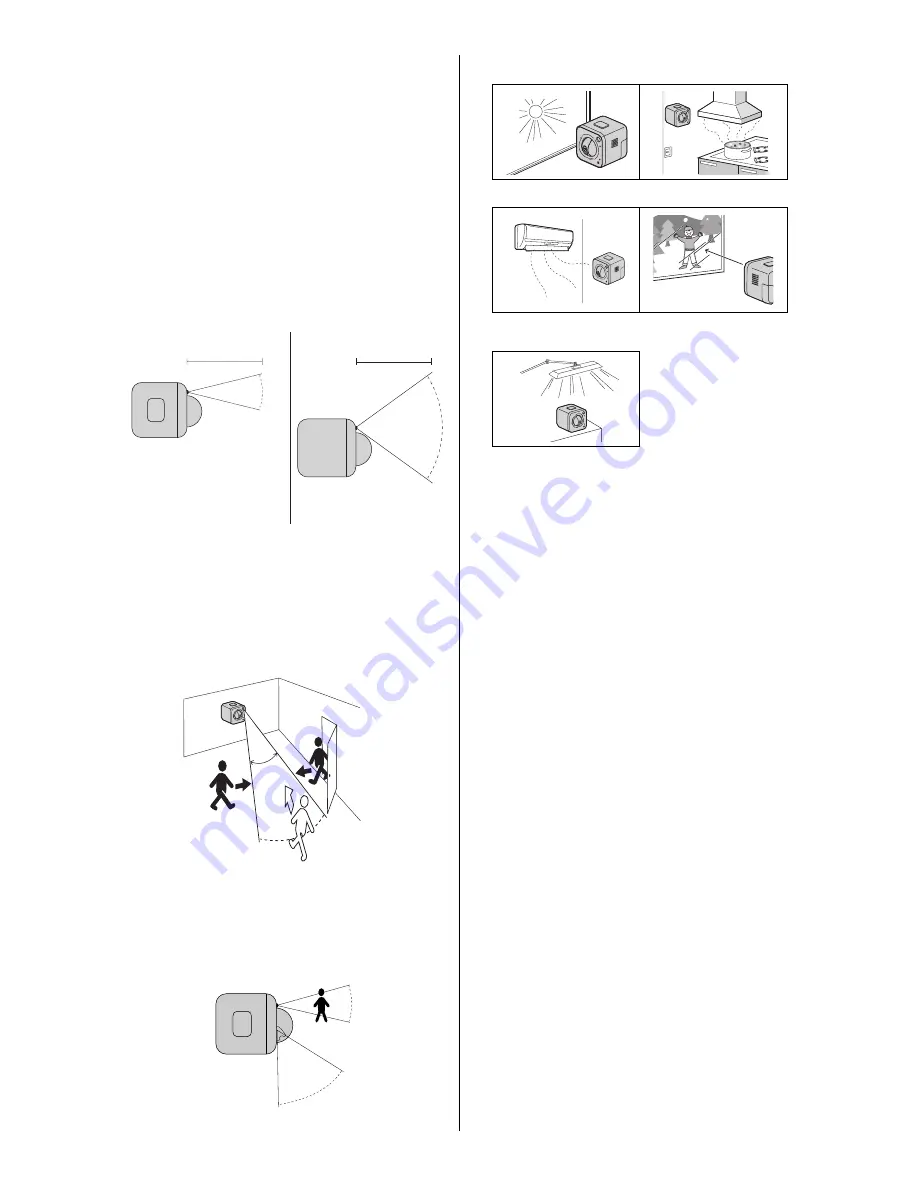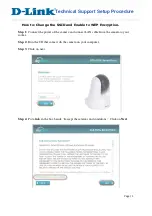
3
Choosing a Location to Mount the Camera
Notes About the Camera’s Built-in Sensor
Please read the following information about the camera’s built-in
pyroelectric infrared sensor before deciding where to mount the camera.
Refer to the Panasonic Network Camera website at
http://panasonic.net/pcc/support/netwkcam/ for further information
about the built-in sensor.
The camera’s built-in sensor is a pyroelectric infrared sensor, which means
it uses infrared rays to detect temperature differences within its range that
are emitted naturally by people, animals, etc. The sensor can be used to
trigger the camera to buffer (i.e., temporarily store) camera images in its
memory. You can view these images later as desired. The sensor can also
be used to trigger the camera to transfer images to someone or
somewhere, by FTP, E-mail, or HTTP.
Because the detection range is easily affected by the temperature of the
surrounding environment or how fast the objects in front of the camera are
moving, you should take the following into consideration when deciding
where to mount the camera.
1.
The sensor’s active detection range is about 5 m (16 feet 5 inches) in
front of the camera, about 28° horizontally, and about 71° vertically,
when the camera is in a 20 °C (68 °F) environment.
2.
If an object is within about 1 m (3 feet 3 inches) of the camera, the
sensor may detect the object even if it is outside of the sensor’s range.
3.
If there is no temperature difference between objects in range of the
camera’s sensor and the surrounding environment, such as on a hot
summer day, the sensor may not be able to detect properly.
4.
If the sensor is obstructed, the sensor is not able to make detections.
Remove any obstacles in front of the sensor.
5.
As shown in the illustration below, the sensor can easily detect
temperature differences of objects moving sideways within the
detection range, but cannot easily detect objects moving slowly
towards the sensor. Mount the camera where objects often pass the
camera from the sides.
6.
If the lens is aimed at an area outside of the sensor’s active detection
range, the objects that trigger the sensor may not be visible, and
therefore buffered or transferred images may not show the object that
triggered the sensor.
In the example below, the person has triggered the sensor, but the
person is not in the visible range of the camera.
We recommend that you limit the pan and tilt range of the camera to
the active detection range of the sensor, or that you limit other user’s
access to the pan and tilt features.
7.
The sensor may not perform properly in the following areas. Avoid
these kinds of locations when mounting the camera.
8.
When deciding where to mount the camera, you can verify the
sensor’s ability to make detections that satisfy your needs by referring
to the camera’s indicator. See 7.5 Changing the Indicator Display in
the Operating Instructions on the CD-ROM, and configure the camera
to light the indicator in orange when the sensor makes a detection.
You can then adjust the sensitivity of the sensor (see 2.9 Adjusting
Sensor Sensitivity in the Operating Instructions on the CD-ROM) or
change the camera’s location if necessary. Note that if you increase
the sensitivity of the sensor, the sensor may make inaccurate
detections.
Note
• If you are not satisfied with the sensor’s ability to make detections,
we recommend using the camera’s motion detection feature. This
feature detects motion by detecting changes in the camera image.
For more information, see Section 2 Using Triggers to Buffer and
Transfer Images in the Operating Instructions on the CD-ROM.
• The built-in sensor and the motion detection feature are not
designed to be used for security or surveillance. No responsibility
will be taken by our company with respect to consequences
resulting from the use of these features.
PRIVACY Button
Privacy mode allows you to protect your privacy by hiding the lens inside
the camera, preventing camera images from being seen. You can turn
privacy mode on by pressing the PRIVACY button on the front of the
camera.
When privacy mode is turned on, the PRIVACY button (which also serves
as the camera’s indicator) changes from green to red to let you know that
privacy mode is activated. To turn privacy mode off and allow the camera
to be accessed, simply press the PRIVACY button again. It should turn
green within a few seconds.
If users are accessing the camera when privacy mode is turned on, the
camera image area displayed in their web browsers turns gray or black. No
camera pages can be accessed by users while privacy mode is turned on.
Once privacy mode is turned off, users can press the refresh button in their
web browsers to view images again.
The camera’s administrator can also turn privacy mode on and off using a
PC or a mobile phone, and the PRIVACY button itself can be disabled so
that privacy mode cannot be turned on or off by pressing the PRIVACY
button.
For more information about privacy mode, see 7.6 Privacy Mode in the
Operating Instructions on the CD-ROM.
Note
• If you plan on using the PRIVACY button to turn privacy mode on
and off, make sure you mount the camera where you can reach the
button.
Other Notes
• Camera images can be viewed in relatively dark areas, however, image
quality decreases when viewing dark images. We recommend using
supplemental lighting for best results.
• Prolonged exposure to direct sunlight or halogen light may damage the
camera’s image sensor. Mount the camera appropriately.
About 5 m
(16 feet 5 inches)
Top View
Side View
About 28°
About 5 m
(16 feet 5 inches)
About 71°
Difficult to detect
(The detection range
may be reduced)
Easy to detect
Easy to detect
58°
28°
• Where the camera or the object
is exposed to direct sunlight
• In a greasy or humid place such
as a kitchen
• Where there are sharp
temperature changes such as
near an air conditioner
• Where there is an obstacle such
as glass in front of the camera
• Where the camera or the object is exposed to bright light






















